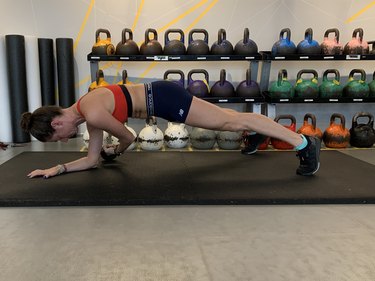
Just when you think you've tried all the plank variations, we're serving up another: the kettlebell drag. Unlike some of the more dreaded ab exercises (hello, crunches), this move will fire up some of the harder-to-activate muscles in your core. All you need is a kettlebell (or dumbbell) and a few feet of space.
Ease into this exercise, starting with just a few reps at a time and really focusing on maintaining proper form. Before long, you'll be a kettlebell drag master.
Video of the Day
Video of the Day
What's the Kettlebell Drag?
If you haven't heard of the kettlebell drag, you're not alone. But even though this exercise isn't too common, anyone can benefit from incorporating this core-strengthening exercise into their usual ab routine. Before you give this move a try, follow these steps to perfect your form:
How to Do the Kettlebell Drag

- Begin in a forearm plank, elbows directly below your shoulders, and toes, hips and head in a straight line. Position your feet wider than hip distance to form a stable base, and keep your hips low.
- Place the kettlebell just behind your right hand.
- Engaging the glutes, low back and abdominal muscles, reach the left arm across the chest to grab the kettlebell, dragging it on its side by the handle under your body.
- Pause when the kettlebell is just behind the left hand, stacked below the shoulder.
- Repeat on the opposite side.
"The key is to have as little movement as possible through the body, aside from the arm pulling the weight," says Melissa Wolfe, Mile High Run Club instructor who often features this move in her workouts. "Hips and shoulders should remain exactly square to the ground without rotating open to the sides and weight/balance should remain equally distributed through the legs."
You'll also want to choose a weight that's a bit lighter to start. You're not swinging or deadlifting this weight, so you won't have the bigger muscle in your lower body to help you out. It doesn't take much to get your abs working, especially since you're also holding a plank. And it's better to start off light and increase from there than go heavy and injure your back.
Read more: 3 Ab Exercises That Aren't Worth Your Time
Incorporating the Kettlebell Drag
Core-strengthening exercises (like the KB drag) are a must if you're aiming for amazing abs. But there are plenty of other functional benefits these moves provide. The muscles in your core keep your body stable, initiate movement and help improve your posture and balance, according to a November 2013 study published in Sports Health.
The kettlebell drag, specifically, also helps strengthen the core muscles that wrap around your low back and hips, including those often-neglected obliques, Wolfe says. "Strengthening these areas allows us to maintain a proper lifted alignment through the spine in daily posture," Wolfe says. "In terms of performance, the better conditioned we are to carry our bodies well, the better we will perform."
Wolfe recommends integrating this anti-rotational exercise into your workouts about three times per week. But start small, only doing the exercise for 20 seconds, followed by a 30-second rest. Then when you're more comfortable, progress to three rounds of 15 reps.
Was this article helpful?
150 Characters Max
0/150
Thank you for sharing!
Thank you for your feedback!